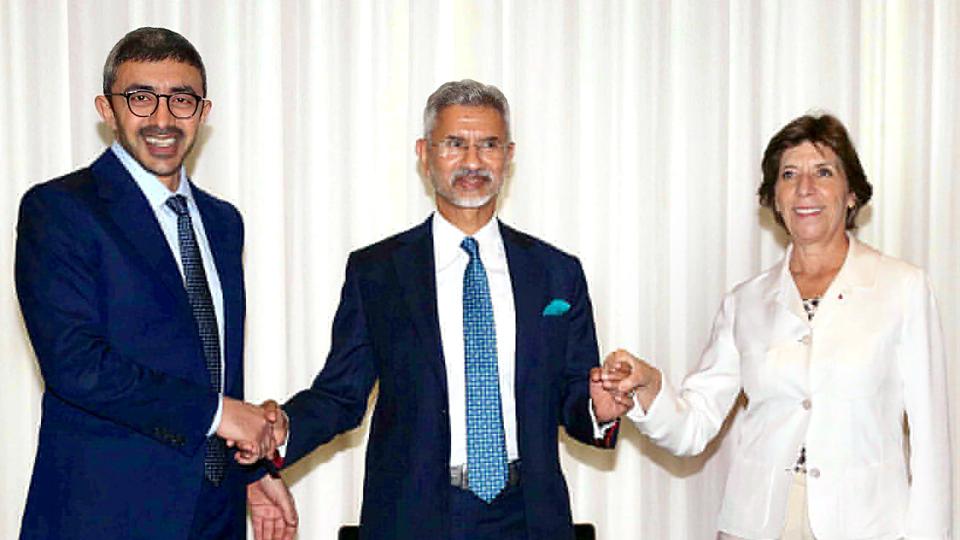India’s trilateral diplomacy format in New York
The article has been authored by Shrabana Barua, research fellow, Indian Council of World Affairs, New Delhi.
Last month, external affairs minister (EAM), S Jaishankar’s sojourn in New York drew much applause. Reportedly, 50 meetings were conducted in just ten days, between September 18-28. New Delhi’s focus revolved around positioning its agenda of renewed multilateralism at the 77th United Nations General Assembly (UNGA-77), among discussing the many challenges in a tense geopolitical environment of the current times. However, what merits attention is also the various discussions that were held on the sidelines of the UNGA events and beyond. This included India’s interactions within forums such as India-Brazil-South Africa (IBSA), Quadrilateral Security Dialogue (Quad), Brazil-Russia-India-China-South Africa (BRICS), the L.69 group, Caribbean Community (CARICOM), to name a few. Among all these, India’s progress in four of the trilateral meetings needs highlighting.

The IBSA Dialogue Forum was formed in 2003 as a result of the Brasilia Declaration. Though the initial focus remained on pushing for reforms at the UN, IBSA has evolved as an important forum to discuss diversified but common issues, reflecting South-South cooperation.
As the incumbent chair of the IBSA grouping, India hosted the 10th IBSA Trilateral Ministerial Commission Meeting on September 21 in New York. In general, there was a push for discussing issues of the Global South and cooperating on it through multilateral and plurilateral forums (including WTO, G-20, UN, WIPO). It sought to reform global governance, at a time when developing States are still reeling under negative impacts of Covid-19; 11 global issues and three regional issues were taken up in this meeting. Within the former, many overlapped with agendas discussed under the UNGA aegis. Additionally, the IBSA Trust Fund that has so far supported 39 South-South development projects in 34 partner countries was emphasised upon. Similarly, the establishment of the IBSA National Security Advisors Meeting (which was held for the first time in August 2021) to cooperate over matters of security and international terrorism was appreciated. There was also an effort to outline sectoral areas under IBSA and facilitate people-to-people cooperation. This allows IBSA as a forum to potentially impact the daily lives of people beyond discussing what is commonly considered high issues of politics and security. Among the regional issues, African Union, Middle East and Ukraine were deliberated upon. These developments leave India with a range of preparations to be made to fruitfully host the 6th IBSA Summit in November this year, on the side lines of the G-20 Summit in Bali.
The India-France-UAE (I-F-U) conducted its first ministerial meeting under this format in New York on September 20. Earlier, in July 2022, the group had met for the first time to explore avenues of cooperation in the Indo-Pacific region, including in maritime security, humanitarian assistance and disaster relief (HADR), connectivity, supply chain resilience, among other areas. Given the current defence and strategic cooperation that already exists at a bilateral level with India, this group is expected to emerge well, “as a strong pillar shaping the strategic dynamics in the Indo-Pacific”, as international affairs expert, Dr Jagannath Panda, describes. The recent meeting of the I-F-U hints at a small step in this direction, though the scope of it is yet to be seen.
The India-France-Australia group on September 23 on the sidelines of UNGA-77. It had begun with the foreign secretary level meetings in 2020. It was elevated to the ministerial level, with its first such meeting held in London in May 2021, and a joint statement released of the same. Revolving around the common desire for a free, open, inclusive and rule-based Indo-Pacific, the group committed to Asean Centrality and Outlook on the Indo-Pacific. The document also acknowledged progress made along three pillars within this trilateral format - maritime safety and security, marine and environmental cooperation, and multilateral engagement. However, despite some of these developments, France was reportedly unhappy about the submarine deal between Australia and UK under the banner of AUKUS done last year. As a result, France had begun to withdraw from engagements with Australia. The recent trilateral meeting, therefore, was seen as a progressive step to seek solutions and cooperate among states with stakes in the Indo-Pacific.
Australia-India-Indonesia (AII) was formulated in 2017, it met as a group for the first time in September 2022 in New York. As areas of convergences, including maritime issues, blue economy, clean energy among others are apparent, cooperation between them is expected to contribute to Asean centrality in the Indo-Pacific. Dr Rajeshwari P Rajagopalan of the Observer Research Foundation writes that, “AII is perfectly positioned to emerge as a key regional trilateral mechanism in the post-pandemic order”. The recent meeting certainly adds support to such a statement.
Two main conclusions can be drawn from India’s pursuits through trilateralism. First, trilateral formats of diplomacy provide the added advantage of moving beyond problematic areas of a bilateral relationship and focus on common issues, as the case of India-Australia-France shows. India’s increasing power position in such cases is then put to diplomatic tests, making trilateralism a dynamic format of diplomacy. Second, in the coming times, till multilateral mechanisms are reformed or renewed, India’s international agendas shall see push through plurilateral formats, whether trilateral or minilateral. It allows for easier consensus building and finding common grounds of cooperation. How India takes forward such old and new formulations therefore becomes an interesting point of study.
The article has been authored by Shrabana Barua, research fellow, Indian Council of World Affairs, New Delhi.






